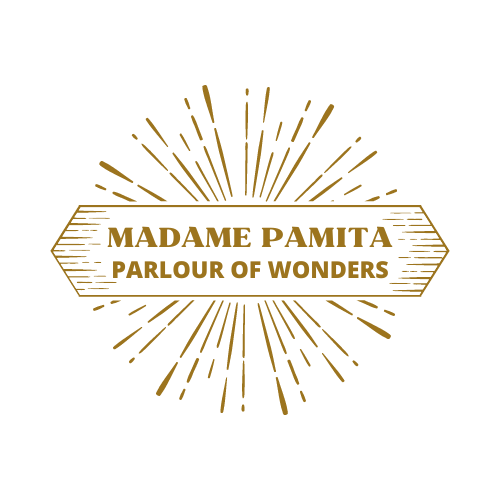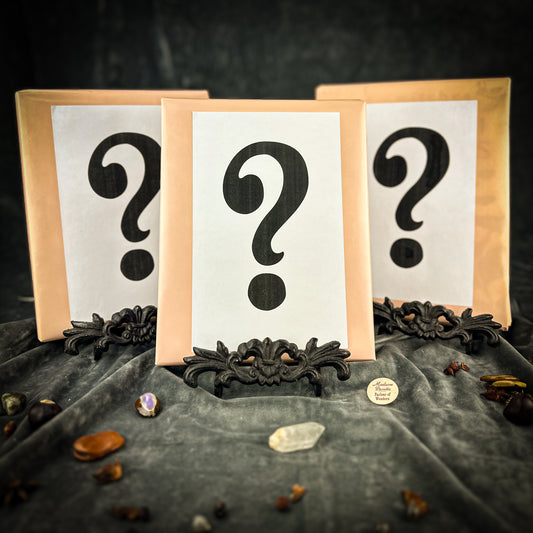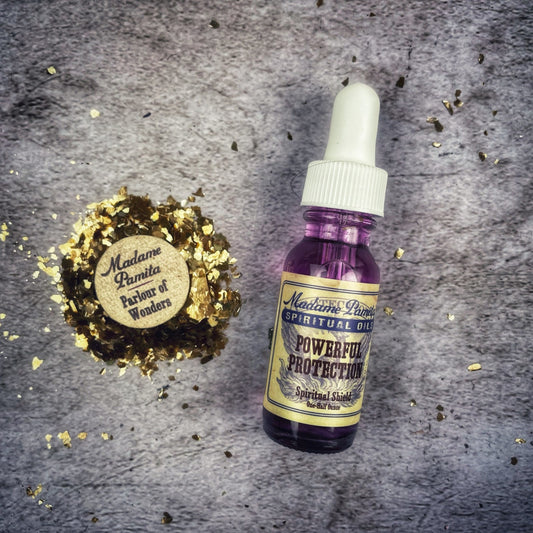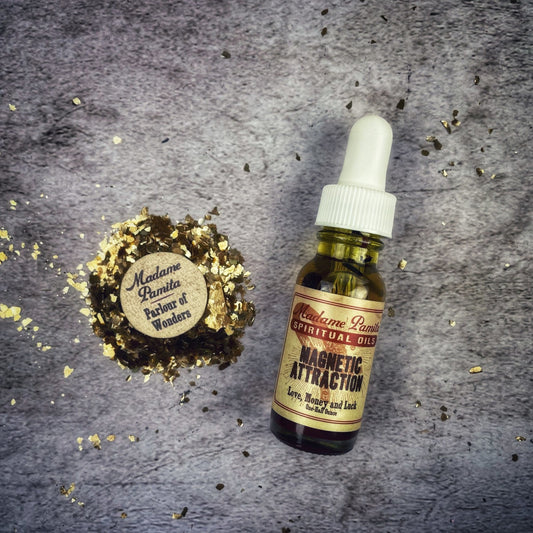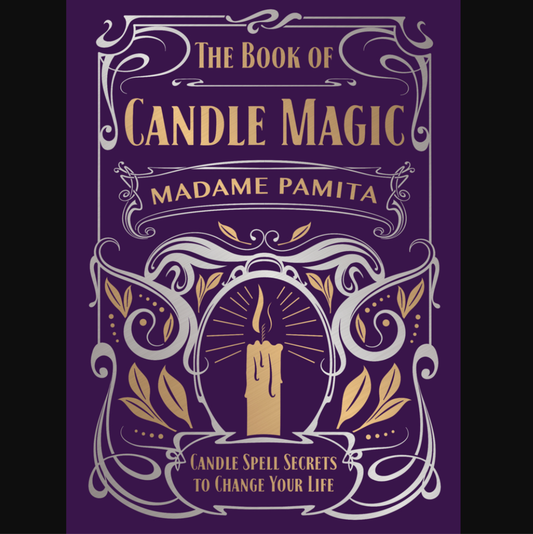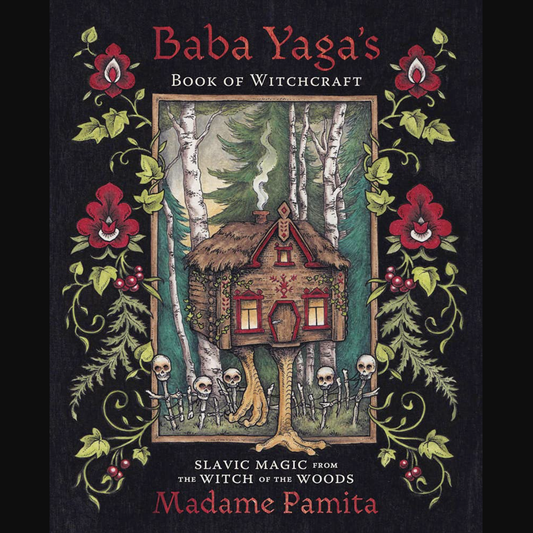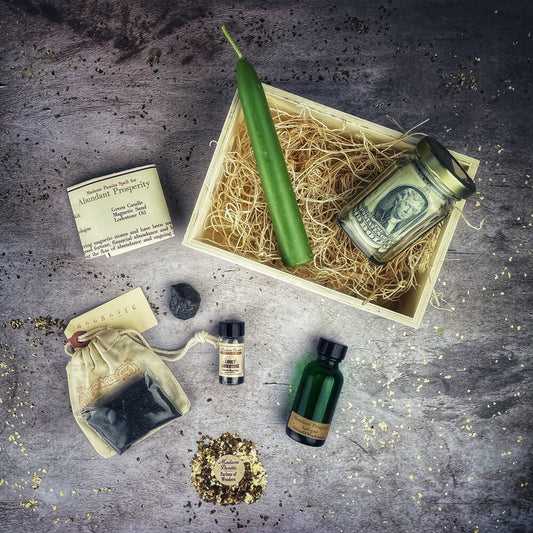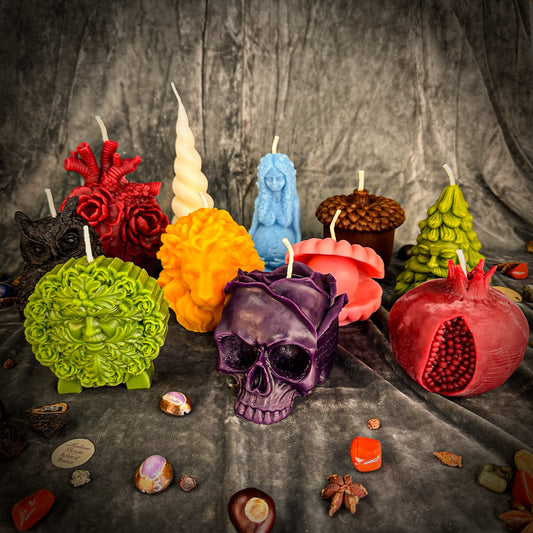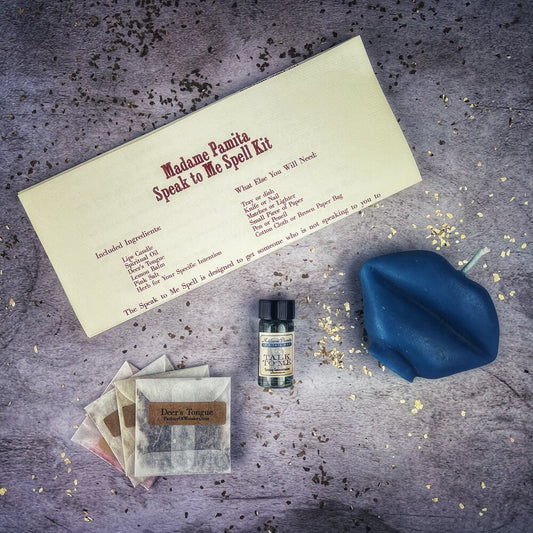
Do You Need a Book of Shadows?
Share
Looking to give your Book of Shadows a head start? Head to this page to find out how to get 13 printable, full-color pages from Madame Pamita's personal Book of Shadows for FREE!
What is a Book of Shadows?
Whether you call it a Book of Shadows, a Book of Shadows and Light, a Grimoire, a Spellbook, or The Book, a Book of Shadows is often a misunderstood concept in magic and witchcraft. To put it simply, a Grimoire is a book of spells or a spellbook.
Most magical shops and bookstores have a magic section with spell books. There might be love spells, there might be prosperity spells, general magic spells, spells in witchcraft. You'll find all kinds of books with spells in them. There is a a difference between a grimoire and a spellbook. A grimoire is more like a textbook of spells, it's teaching you how to do magic. Spell books tell you how to do things; they tell you how to do the spell and sort of do this step-by-step. That doesn't necessarily make that book a grimoire.
A grimoire is more of a book that is teaching you how to do spells and showing you recipes / how you do it, but it's more for your own knowledge and your own learning. A grimoire can be written by someone else, and it will give instructions on how to cast spells and create charms, make amulets, talismans or do divination and even summon spirits.

A Short History of the Grimoire
Grimoires really have existed since ancient times from Egypt, Mesopotamia, and Greece. Jewish mystics also have written grimoire documents. Grimoires appear in the 1700s; there would be a magical book that someone would write with spells, often under a pseudonym because they didn't want to get in trouble for writing down spells or be accused of witchcraft.
In the 1800s, we really started to see these become more available. Examples of 19th-century grimoires that you might have seen include a book called "The Key of Solomon," or "The Sixth and Seventh Books of Moses," or a book that we have at our shop — "The Black Pullet." "The Black Pullet" is a very famous grimoire. These books gave spells and magic, but also gave lessons, with more of a textbook quality to them. We know people have been doing magic and practicing magic since before written history. So why are there not more written grimoires out there?
First of all, most people that were practicing magic, and most people in general, were not necessarily literate. There were people that were well-educated and knew how to read and write. But the average person might not have been literate or able to write down the recipes. They would pass them on from generation to generation but, usually, they were teaching people, initiating people, and showing them how to do magic. Books were also very expensive up until the 20th century. They were for wealthy people with time on their hands. Most of the book magic wasn't done by wealthy people with lots of time on their hands. It was done by people who were disempowered; farmers or agrarian or village people. They were not people who had the ability or the resources to write a book and get it published.
Witch Hunts Play a Major Factor
There were the witch hunts that were going around. So for many, many centuries, having a book of magic would have been a very incriminating thing. It wasn't to your advantage to have a book of magic; it was much better to learn from someone and have it stored in your head.
Even today, there are countries around the world where witchcraft laws are still on the books and witchcraft is punished. It’s not like here, where witchcraft can freely be practiced as a religion and, if you're a witch, you have no problem. You're not going to get thrown in jail for doing it. But that's not the case in other countries throughout the world, and certainly not throughout history. That's why we find there are so few grimoires showing up until maybe starting into the 1800s, the 19th century, and the 20th century. In the latter part of the 20th century is when we start to see grimoires showing up.
The Difference between a Book of Shadows and a Grimoire
People use the phase "Book of Shadows" and "Grimoire" sort of interchangeably, but they are different. A Book of Shadows (sometimes called a BOS for short) is a religious text — an instruction book for magical rituals. Book of Shadows sounds like something that goes back to ancient times. But actually, the term Book of Shadows was only really introduced to us in the 1940s!
In the late 1940s, Gerald Gardner, the founder of the religion of Wicca, invented the term. Gardner defined it as a reference book for a coven, or a group of witches practicing together. Part of their initiation to the Coven was being able to look at and learn from the Coven's Book of Shadows.
Each member would have their own personal Book of Shadows and they would copy the pages from the group coven’s book into their own personal one. Once they did that, they could also add their own pages into their book to customize it for their own needs.
A lot of times, we think of a Book of Shadows as being your personal book of magic when, originally, it was a Coven's group book. It a reference book that they would use for their rituals, as well as a place to store their rules and important information. But for a solitary witch it can also be a personal journal, where you write down the important magical information that you're learning.

What’s in a Grimoire?
You can almost think of it as a textbook that you're writing for yourself. First of all, you would write down what you're learning in magic. As you're learning your magic, you might find an interesting tidbit of information - write it in your Book of Shadows! Maybe, for example, it's color correspondences, or maybe it's a spell that you did or learned about. Perhaps you're crafting some incantations for some spell work. Petition paper words, divination techniques, rituals, recipes, or correspondences — any of those things can be included as part of your Book of Shadows! Think of this as it being your personal journal of your magic and a reference book that you can go back to.

Why you need a Book of Shadows or Grimoire
So if there are plenty of spell books out there, why do you need a Book of Shadows? Number one, it's personal. What's important to someone else might not be important to you, and what's important to you might not be important to someone else. Having your own Book of Shadows is going to be like a customized textbook that you create for yourself.
Another aspect of the Book of Shadows that I find so valuable is that, by writing down and recording this information in some way, you are more likely to remember it. When you write your notes, there's something that happens in your brain that reinforces the information. So if you are copying something down into a book, you are going to remember it better than if you just read it. It’s sort of activating a deeper, richer, more memorable understanding of that topic that you're writing about.
It allows for creativity as well! Not only are you just copying something down, but you actually may have insights or information, and you can add that information to what you're copying. So let's say you are copying color correspondences. In my book "The Book of Candle Magic," there's information about color magic, and there's other information you can find on colors in a lot of other places. So let's say you have some insight about a color and it isn't in my book. As you copy it over to your book, you can add your own insights into what that color could be used for in a magic candle spell.
A Textbook By You for You
I love the creative aspect of keeping a Book of Shadows. Get really creative! You can do drawings, you can decorate it, you can use calligraphy - get fancy with it if you want to! But even just writing it down is going to have such great benefit for you. Not only that, but you can also go back and look at what you have written.
You've done a spell, you write it down, you do the spell, and it has an amazing result. Let's say, a year later you want to replicate that spell. Do you rely on your memory? You don't have to! Go back and look at what you wrote. You can just copy that spell and do it all over again and get that same great result again.
Another aspect of looking back at what you've written is that it allows you to see how you've grown in your practice of using magic and spells. It shows you, “Oh yeah, remember when this was really new to me and I didn't know it very well and I was writing it down? Now, it's second nature to me.” That can also be very encouraging, and give you benchmarks for seeing how far you've come because we always think, "I have so much more to learn," right? This allows you to see how far you've come and that can be a very encouraging thing.
Another thing I think is so great is that it's your information. You know what's important to you. You don't have to go thumbing through someone else's book. You'll find exactly what you need in your Book of Shadows because it's for you. A textbook created for yourself. I think there's something very, very wonderful about that.

What Do You Put In Your Book of Shadows?
When you're creating a Book of Shadows, what format it take? Traditionally, it was a handwritten book. You would just have a normal journal, and you would write down your information in that journal. It could be a blank book, with lined paper, or graph paper, or whatever feels best to you. But you can also get very creative with it. You can paste pictures in it and you can treat it like a scrapbook — paste things inside, put stickers on it, draw in it. There's so much that you can do.
If that doesn't appeal to you, you can do something else: You can have a book of shadows binder. What advantage does the binder give? You can organize your pages, and reorder them at any time. You’re going to have a page about divination and then you're going to have a page about color magic, then you're gonna have a page about herbs, a page about incantations. But after a while, you might want to organize these pages. With a binder, you can reorder those pages easily!
You can put them in plastic sleeves and have them organized in a way that makes it easy to find once you've gathered a lot of information. You can also remove or change pages. Maybe you did a page 10 years ago and you're finding out "oh, there's so much more information. I'd like to redo this page," and a binder will give you the opportunity to do that.

Different Kinds of Book of Shadows
Another thing that's really good is that you could create a digital document. It doesn't have to be an actual book. Why not create a digital Book of Shadows? You can type things into a document and put them into a folder on your computer. Or you can do is scan the pages. Make drawings and scan them. Or find things and those. You can find things online and copy those.
There's so much that you can do there. I think that the best, though, is when you create it. Whether you do it digitally or physically, creating it yourself is a much more memorable experience. If you look online, like on Etsy.com, you can find books and pages that you can purchase. You can even purchase pages from my Book of Shadows here at Parlour of Wonders, or get them for free by Joining the Spell Squad!
But they're missing the component of you creating it and drawing it and drafting it. Some artists have created beautiful book of shadows pages. You can download them, print them, and put them in your binder and create a book for yourself that way. But it becomes a very, very personal, very living sort of thing when you start working with a grimoire. This textbook that you have created for yourself — and it becomes a really valuable tool.
Go Ahead And Start Your Spellbook!
In my book "The Book of Candle Magic," I have a section on creating a grimoire for your candle magic. It outlines the things you should or could be recording that are going be helpful for you. When did you start your spell? When did it finish? What colors did you use? Which spiritual oils did you use? When did you get a result? Those are all things to record in your Book of Shadows.
You might have a book where you jotting down your tarot readings and track what the result was. We call that a tarot journal, but you could consider it a Book of Shadows or a Grimoire. So when you do that, make sure you record your spells so that you can reference and replicate them. Jot your notes down so that you can go back and see "What was that brilliant idea I had? Oh, yeah! There it is, in the book."
So, I really encourage you to start making a grimoire for yourself. Get a journal, a binder, or create a computer folder where you can put documents. Start writing down what you're learning in magic. You can write down your spells and get into details and show what the results were of those spells. Or write create incantations. You can write about divination techniques that you're using or trying, and seeing the results that you get. You could do talking to your spirits, automatic writing. These are all things that can go into your grimoire; rituals, recipes, correspondences — all of it can go there.
